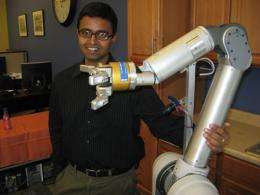Robotic arms: Rubbing elbows with robotics (w/ Video)

Brian Zenowich will sometimes spend his workdays doing a little arm-in-arm dancing. His dance partners manage to stay in step, duplicating his every move almost flawlessly. The "twist" here isn't the type of dance he's doing. It's the fact that Zenowich isn't dancing with humans. He's actually a robotics engineer for Barrett Technologies in Cambridge, Mass., where the company makes robotic arms and hands.
They're called WAM arms and "W-A-M" is an acronym for "Whole Arm Manipulator." The arms can be sold with attachable robotic hands, too. Zenowich demonstrates how to control the robotic WAM arms and hands of one robot by gracefully moving similar parts on another robot.
"It's a very visceral experience," says Zenowich. "You are in contact with this machine and you're working back and forth with the robot and it's like a dance that you're doing with the robot."
Zenowich operates a master robot, while the slave copies his moves remotely. He's able to pick up a small box, place a coffee thermos on top of the box, and top the thermos with at baseball cap. "You get both the skill of the person, the intelligence of the person and the speed of the robot working together to perform a task," explains Zenowich.
For robot parts to act and react like people parts, Barrett needed to make them small and portable, with maximum agility. With help from the National Science Foundation's Small Business Innovation Research (SBIR) program, his company developed a computerized device that looks like a small hockey puck. So much so that they even call it a "puck."
"A puck is a motor-controller, which goes into all of our products that controls the motors and moves them with as much force--as much torque, as we need them to move," says Zenowich. "Just as people move around, we want our robots to move around so they needed to be small and lightweight and low power."
The puck allows the arms and hands to be utilized in many ways. The operator can actually sense virtual objects through the touch of the robot. "When you are in contact with the robot, you can actually feel objects in 3-D space: the robot will create that virtual environment for you in a physical sense."
That sensing of virtual objects can be programmed into the robot's memory and is useful for applications such as physical therapy. "The Rehabilitation Institute of Chicago is using our robot to perform rehabilitation on stroke patients to make them stronger; to get their brains to really understand what the aftereffects of the stroke were." Patients will push on the arm and hit imaginary objects they can feel through the robot arm.
There are other functions of the arms and hands made by Barrett. Telerobotics allows for remote operation of the arms and hands, which could be a boon for the military. "The robot can go in remotely under human control and can disarm the explosive device," says Zenowich.
Another application is "teach and play."
"It's very easy to teach our robot to make even complex motions like writing," he says. The robot can be programmed to automatically understand what to do. "So if you put a pen in the robot's hand, it would know it's supposed to write something with that pen."
With improved technology, robots can be used more efficiently and in wider applications. According to SBIR program manager, Muralidharan Nair, in the past, most robots were assigned to repetitive tasks in industry with only recent entry into product assembly. "However, the growing needs of aging populations will dwarf these traditional industrial uses," says Nair.
And addressing these quality-of-life needs with robots will require continued improvements in intelligence and sensing capability. "The NSF/SBIR program investments in robotics technology have typically been made in the areas of human assistive technologies, healthcare robotics, education, robotics in manufacturing, and emergency response. The program has been critical to Barrett's success with the robotic arm," adds Nair.
The WAM arms use roughly the same amount of power as a light bulb and can also be used in factories. Most robotic arms don't know their own strength and accidents on assembly lines from robotic arms can fatally crush their human counterparts. But the WAM arm is designed to know its own strength. That's because the robotic arm functions with truly sensitive, sophisticated controls, so humans are not at risk in the presence of these machines.
"If the robot is in a manufacturing environment and gets in the way accidentally, the robot's not going to push through that person. The person is always stronger than the robot, and can push the robot out of the way," explains Zenowich.
"If technologies developed by Barrett are leveraged by a large U.S. corporation, the NSF/SBIR investment in Barrett can have a profound effect on the U.S. economy and quality-of-life for the aging population around the globe," says Nair. "Robotics will also become critical in healthcare, biomedical research and outcomes, and surgical procedures."
Most of the WAM arms and hands are sold to research wings of corporations or universities. Zenowich is impressed with how many different ways the robot arms are being used. "It's amazing to see all the applications where our robots are working directly with people and helping them in some amazing way," notes Zenowich.
Provided by National Science Foundation


















